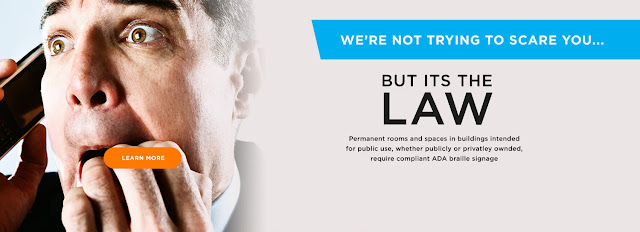It's not just an arbitrary set of rules. ADA sign compliance is about removing unnecessary barriers for your patrons, employees and customers. A specific set of requirements exists for your interior wall signs as set forth by the Department of Justice’s Americans with Disabilities Act and their approval of the 2010 ADA/ABA Accessabilty Guidelines. Here are the top 6 reasons why your interior signs may not be ADA compliant:
1. Letter Height. Are characters too big or small? From the 2010 Standard for Accessible Design:
703.2.5 Character Height. Character height measured vertically from the baseline of the character shall be 5/8 inch (16 mm) minimum and 2 inches (51 mm) maximum based on the height of the uppercase letter “I”.
Simply put, interior ADA compliant wall signs should have characters no smaller than 5/8” and no bigger than 2”. It’s also important that these characters are all CAPS, a sans-serif font, and not too bold or condensed.
703.2.2 Case. Characters shall be uppercase.
703.2.3 Style. Characters shall be sans serif. Characters shall not be italic, oblique, script, highly decorative, or of other unusual forms.
703.2.4 Character Proportions. Characters shall be selected from fonts where the width of the uppercase letter “O” is 55 percent minimum and 110 percent maximum of the height of the uppercase letter “I”.
2. Character Spacing. Do the letters seem to all run together? Often overlooked when making signs, there needs to be a minimum of 1/8” between the two closest points of adjacent tactile characters, excluding word spaces. What this usually involves when making a compliant sign is spacing characters out a little more than normal, keeping close attention to some character combinations that may graphically be closer than others.
703.2.7 Character Spacing. Character spacing shall be measured between the two closest points of adjacent raised characters within a message, excluding word spaces. Where characters have rectangular cross sections, spacing between individual raised characters shall be 1/8 inch (3.2 mm) minimum and 4 times the raised character stroke width maximum.
3. Line Spacing. Spacing between baselines of separate lines of raised characters should be 135 percent minimum and 170 percent maximum of the raised character height. Often when designing signs, the interline spacing is decreased to allow more lines of text to fit within the sign space. Doing so may be non-compliant if the lines are too close together, and do not fall within the specified 135-170 percent range.
703.2.8 Line Spacing. Spacing between the baselines of separate lines of raised characters within a message shall be 135 percent minimum and 170 percent maximum of the raised character height.
4. Pictograms and a 6” Field. Pictograms should have a field height of 6 inches. Signage with symbols such as the man or women symbol on restroom signs require a six inch high background field where characters and braille do NOT exist. Other pictograms in question tend to be those related to signs that are used to designate various rooms and spaces. Pictograms such as those for maps and plans do not need to comply.
703.6.1 Pictogram Field. Pictograms shall have a field height of 6 inches (150 mm) minimum. Characters and braille shall not be located in the pictogram field.
5. Finish and Contrast. This requirements is straightforward stating that interior ADA compliant wall signs need to have a non-glare finish, and symbols of accessibility shall contrast with their background, meaning either a light colored symbol on a dark background or vice-versa. Signs are more legible for those with vision disabilities when characters contrast as much as possible with their background, and surface glare is minimized.
6. Compliant Braille. All sorts of rules apply to the braille that accompanies raised text including position, dot height, spacing, etc. Currently, Grade 2 contracted braille is required, which is a condensed version of braille using 189 contractions and shortened forms of words. Common braille mistakes in ADA signage include using Grade 1 braille where words are spelled out letter-for-letter instead of the contracted Grade 2 braille. Other errors include not locating braille at least 3/8” minimum from raised text, and limiting capitalization only to the first word of sentences, proper nouns/names, individual letters of the alphabet, initials and acronyms.
Ultimately design and manufacturing of ADA compliant interior signs that identify permanent rooms and spaces as required by ADA can be challenging if manufactures are not up-to-date on the rules and regulations. That is why all of us at JustBrailleSigns.com pride ourselves on knowing these intricate regulations and codes for ADA Signage. That being the case... let us know if we can help, and rest assured, your signs are made right at justbraillesigns.com.

